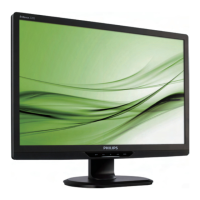
Do you have a question about the Philips 220S2 and is the answer not in the manual?
| Brightness | 250 cd/m² |
|---|---|
| Response Time | 5 ms |
| Connectivity | VGA, DVI-D |
| SmartContrast | 20, 000, 000:1 |
| Built-in Speakers | No |
| VESA Mount | 100 x 100 mm |
| Contrast Ratio | 1000:1 |
| Backlight Type | LED |
| Viewing Angle | 170° horizontal, 160° vertical |
| Display Colors | 16.7 M |
| Scanning Frequency | 30 - 83 kHz (H) / 56 - 75 Hz (V) |
Warnings, operation, and maintenance guidelines for safe usage and care.
Explanation of icons used for notes, cautions, and warnings.
Environmental disposal guidelines and recycling information.
Details on package contents and how to attach the base stand.
Instructions on connecting the PC and basic operation of controls.
Instructions for adjusting the tilt angle of the monitor.
Instructions for adjusting the swivel angle of the monitor.
Instructions for adjusting the height of the monitor.
Explanation, benefits, and working of SmartImage presets.
Step-by-step guide to activate and use the SmartImage feature.
Explains what SmartContrast is, why it's needed, and how it works.
Details on SmartSaturate technology for color saturation.
Details on SmartSharpness technology for image clarity.
Introduction to the SmartControl Premium software for monitor control.
How to use the Adjust menu for brightness, contrast, focus, position, resolution.
How to adjust RGB, Black Level, White Point, Color Calibration, SmartImage.
Steps for calibrating display colors for accurate output.
Power saving features and schedule settings.
How to enable and manage the Theft Deterrence feature.
Settings for desktop menu, task tray icon, transparency, and language.
Managing input sources and settings.
Adjusting volume and mute settings for integrated speakers.
Enabling automatic screen rotation.
Accessing the user manual and technical support.
Displaying software version and system information.
How to use the task tray menu for quick access to features.
Settings for disabling the task tray icon and related options.
Describes bright dot and black dot defects, and sub-pixel types.
Acceptable levels for bright dot, black dot, and total dot defects.
Specifications for LCD panel, backlight, aspect ratio, resolution, etc.
Details on signal inputs and compatibility.
User convenience features like OSD languages and VESA mount.
Specifications for tilt, swivel, and height adjustment.
Power consumption details in various modes and voltage inputs.
Physical dimensions of the monitor with and without stand.
Weight specifications for the monitor and packaging.
Environmental and operating conditions like temperature and humidity.
Information on ROHS, EPEAT, and packaging materials.
Lists regulatory approvals and certifications.
Details on monitor color and finish options.
Information on lead-free manufacturing and environmental compliance.
Details on TCO Certified standards and usability features.
Information about the EPEAT environmental assessment tool.
Advantages of EPEAT certification for product sustainability.
Compliance with various safety and EMC standards.
Information on Energy Star compliance and power saving features.
How to find warranty details for your country/area.
Overview of the Philips First Choice warranty program and its benefits.
Details on what is included in the Philips First Choice warranty coverage.
Conditions and situations not covered by the Philips warranty.
How to get support via website for troubleshooting.
How to get support by contacting Philips helpdesk.
Contact details for warranty service in various European countries.
Contact information for consumer support centers in various regions.
Details on who is eligible for warranty service and proof of purchase.
What the warranty covers, including parts, labor, and duration.
Conditions that void the warranty, such as misuse or accidents.
Information on service availability in different countries.
Contact details for Philips Customer Care Center and support website.
Specific warranty details for Philips monitors purchased in the USA.
Terms of the limited warranty for computer monitors.
Solutions for common user-correctable problems with the monitor.
Addresses issues like no picture, blinking LED, and cable connection.
Explains the AUTO button functionality and limitations.
Safety instructions for immediate action if smoke or sparks are observed.
Solutions for issues like centered image, vibration, and vertical flicker.
Adjusting contrast and brightness for image quality issues.
Setting correct resolution for sharp text and image display.
Troubleshooting steps for no sound issues with the monitor.
Steps to resolve issues with non-working USB peripherals.
Answers to frequently asked questions about SmartControl Premium.
How to resolve SmartControl Premium issues after changing PCs or drivers.
Steps to troubleshoot SmartControl Premium if it stops working.
Potential compatibility issues with graphics adapters and SmartControl Premium.
Reasons for incomplete product information and driver update recommendations.
Procedure for recovering a forgotten PIN for Theft Deterrence.
Explains interaction between SmartImage and sRGB color temperature settings.
Information on wall mounting capabilities using VESA standards.
Compatibility of Philips monitors with different computer systems.
Confirmation of Plug-and-Play compatibility with various operating systems.
Comparison of different panel technologies like IPS, MVA, and TN.
Answers to common questions about monitor setup, usage, and maintenance.
Steps to resolve 'Cannot display this video mode' error during installation.
Recommended refresh rates for LCD monitors and troubleshooting screen disturbances.
Explanation of driver files and installation process for monitor drivers.
How to adjust display resolution through Windows Control Panel.
How to reset monitor settings to factory defaults using the OSD.
Advice on protecting the LCD screen from scratches and damage.
Recommended methods for cleaning the LCD screen safely.
How to change color settings like temperature and sRGB via OSD.
Explains image retention phenomena like burn-in and ghosting in LCD panels.
Guidance on using the native resolution for sharp text and clear images.